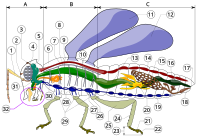
Photo from wikipedia
Abstract The red flour beetle, Tribolium castaneum, is an invasive pest of a variety of stored products that is found in most tropical and subtropical countries. To further understanding of… Click to show full abstract
Abstract The red flour beetle, Tribolium castaneum, is an invasive pest of a variety of stored products that is found in most tropical and subtropical countries. To further understanding of the mechanism of insect-host chemical communication, we examined the morphology, distribution and abundance of various sensilla associated with antennae, palpi, foretarsi and ovipositor by scanning electron microscopy. No sexual dimorphism was found between male and female antennae, palpi and foretarsi. In both sexes, four types of antennal sensilla were characterized: two subtypes of trichoid sensilla (st1-2), four subtypes of basiconic sensilla (bs1-4), multiporous grooved peg (mgp) and styloconica sensilla (sst). Overall, the olfactory and gustatory sensilla were clustered mainly on the three antennal club flagellomeres. The sensory field of both maxillary and labial palps was concentrated on the distal segment forming the chemosensory field. Three types of sensilla on both maxillary and labial palps were characterized: trichodea, basiconica, and two subtypes of sensilla styliconica. Maxillary palps carried higher numbers of all types of sensilla than labial palps. Two types of sensilla were characterized on the fore tarsi: trichoidea and cheatica. Only one type of sensilla was found on the ovipositor, trichodea. The functional roles of these sensilla are discussed in relation to their external structure and distribution. Further anatomical, physiological and behavioral studies on identifying the functional types of these sensilla and their role in the selection of an appropriate food source can provide a basis for the development of semiochemically based control strategies.
Journal Title: Annals of Agricultural Sciences
Year Published: 2018
Link to full text (if available)
Share on Social Media: Sign Up to like & get
recommendations!